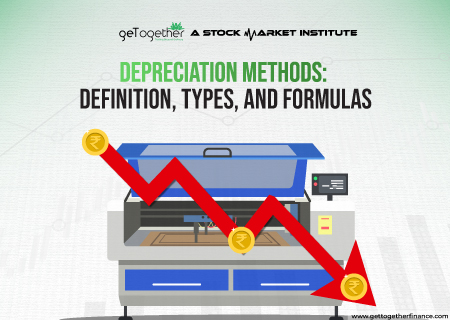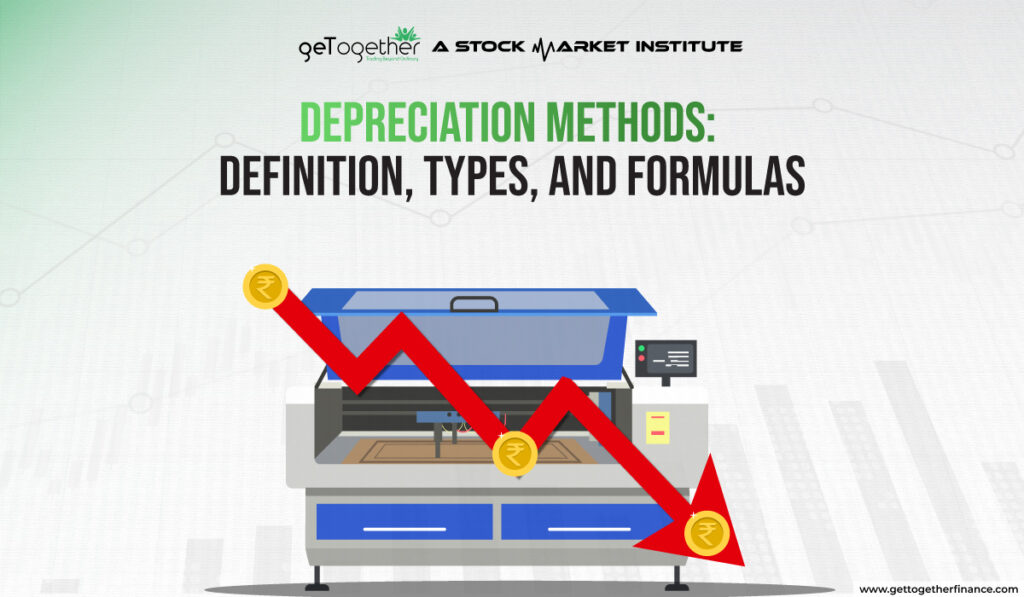Depreciation Methods: Definition, Types, and Formulas


Overview
Often businesses require assets like machinery, buildings, and vehicles to perform day-to-day operations. But just like anything else, these assets lose value over time due to wear and tear, technological advancements, or obsolescence. This gradual decline in value is known as depreciation.
Depreciation is a crucial concept in accounting, as it helps businesses spread the cost of an asset over its useful life. This blog dives deeper into the definitions of depreciation along with the types that are used in the business world. Further, it delves into the need for depreciation methods in accounting and tax in the business world.
Let’s begin with…
What is Depreciation

Depreciation is not about the actual cash outflow for repairs or maintenance. Instead, it’s an accounting technique that allocates the cost of a tangible asset over its estimated useful life. This expense is recorded on the income statement each year, reducing the asset’s book value (recorded value on the balance sheet) and reflecting its decreasing value.
When picking a depreciation method, it’s crucial to consider the asset and how it’s used because this impacts the book value and revenue. It also helps to calculate depreciation in a way that suits different situations. But first, let’s explore different types of depreciation methods.
Types of Depreciation Methods

There are different types of depreciation methods used with different formulas for setting the book value of an asset. However, there are mainly four main depreciation methods used in accounting, each with its own advantages and best suited for different asset types. Here let’s take a look:
Straight-Line Method
This is the simplest and most common method. It allocates the asset’s cost (minus salvage value) evenly over its useful life. The formula is:
Formula of Annual Depreciation Expense = (Cost of Asset – Salvage Value) / Useful Life in Years
For instance, let’s say your company owns a machine costing ₹1,00,000 (One Lakh Rupees) with a salvage value of ₹10,000 and a useful life of 5 years.
The annual depreciation expense using the straight-line method would be:
Annual Depreciation Expense = (₹1,00,000 – ₹10,000) / 5 years = ₹18,000
The straight-line method is ideal for assets with a predictable decline in value over time.
Declining Balance
The declining balance method is a depreciation method commonly used in India to calculate the depreciation expense of an asset over its useful life. Unlike the straight-line method (equal depreciation expense each year), the declining balance method results in a higher depreciation expense in the early years and a lower depreciation expense in the later years. It mainly focuses on depreciating an asset more heavily in the earlier years of its life, reflecting the notion that assets tend to lose value faster initially.
Formula of Declining Balance Depreciation: Book Value x (Depreciation Rate / Useful Life)
For instance, a delivery truck purchased for ₹10,00,000 with a useful life of eight years. Now let’s assume a declining balance depreciation rate of 30%.
- Year 1: Book Value (₹10,00,000) x (30% / 8) = ₹3,75,000 depreciation expense.
- Year 2: (₹10,00,000 – ₹3,75,000) x (30% / 8) = ₹2,62,500 depreciation expense (calculated using the new book value after year 1).
- Year 3: (₹6,25,000 – ₹2,62,500) x (30% / 8) = ₹1,87,500 depreciation expense.
The example shows how the formula of declining balance helps you find out the value of deprecation.
There are several variations of the declining balance method, each with a different depreciation rate. A common variation is the double-declining balance (DDB) method, which uses a depreciation rate that is twice the straight-line rate.
Double-Declining Balance (DDB) Method
This method intensifies depreciation in the early years of an asset’s life, showing a faster rate of decline in value during that time. The formula is:
Formula of Annual Depreciation Expense = (Double Depreciation Rate x Book Value at Beginning of Year)
The depreciation rate is calculated by dividing 1 by the asset’s useful life (e.g., 1 / 5 years = 0.2 for a 5-year life). This method needs to be calculated with the declining book value each year.
The DDB method is mostly suitable for assets that have a higher value in their initial years and become less valuable over time, such as computers or machinery.
Sum-of-the-Years’ Digits (SYD) Method
This method also offers an accelerated depreciation compared to the straight-line method. The technique assigns a higher depreciation expense in the first few years and a lower expense in the later years.
The formula of SYD includes calculating a depreciation fraction based on the remaining useful life and the sum of the digits of the asset’s total useful life.
Formula of Depreciation Expense = (Remaining life / Sum of the years digits) x (Cost – Salvage value)
SYD is one of the useful types of depreciation methods and is appropriate for assets that experience a significant decline in value at the beginning of their useful life.
Units-of-Production Method
This method bases depreciation on the asset’s usage rather than a fixed time period.
The formula is:
Formula of Depreciation Expense = (Number of units produced / Life in number of units) x (Cost – Salvage value)
This method is well-suited for assets where usage directly impacts value, such as production equipment or delivery vehicles.
Most companies stick to a single depreciation method for all their assets, and using different methods is often specific to certain industries. Once a company selects a depreciation method for an asset, they have to stick with it. Changing the method later would mean revising previously submitted financial statements.
Examples of Depreciation Methods
Nothing is better understood without an example.
For instance, a company owns a desk with an estimated useful life of 10 years and a salvage value of ₹5,000 (Indian Rupees). Now the desk’s original cost is ₹25,000 (One Lakh Twenty Five Thousand Rupees).
Straight-Line Method
Following the straight-line method, the annual depreciation expense would be:
Annual Depreciation Expense = (Cost of Asset – Salvage Value) / Useful Life in Years
Annual Depreciation Expense = (₹25,000 – ₹5,000) / 10 years = ₹2,000
This means the company would record ₹2,000 as depreciation expense on the income statement each year for 10 years. The desk’s book value (recorded value on the balance sheet) would decrease by ₹2,000 annually, reflecting its diminishing value.
Double-Declining Balance (DDB) Method (assuming a 20% depreciation rate):
| Year | Beginning Book Value | Depreciation Rate | Depreciation Expense | Ending Book Value |
| 1 | ₹25,000 | 20% | ₹5,000 | ₹20,000 |
| 2 | ₹20,000 | 20% | ₹4,000 | ₹16,000 |
| 3 | ₹16,000 | 20% | ₹3,200 | ₹12,800 |
As you can see, the depreciation expense is higher in the initial years using the DDB method compared to the straight-line method. This reflects the faster decline in the value of an asset in its early years.
Depreciation and Business and Accounting
Depreciation is a critical concept in accounting also known as non-cash charge as it doesn’t reflect an asset’s declining value over its useful life. While the company might pay the entire cost of the asset upfront, depreciation allows them to spread this cost out as an expense on the income statement over multiple years. This aligns with the matching principle, ensuring expenses are recorded in the same period as the revenue the asset helps generate.
In simpler terms, depreciation reflects how much of the asset’s value is “used up” each year. This expense reduces the company’s reported earnings but also provides a tax advantage by lowering their taxable income. The specific rate at which an asset depreciates is determined by the depreciation method chosen and the asset’s estimated useful life.
Also Read: Depository Receipts
Depreciation and Taxes

The relationship between depreciation and taxes is an interesting interplay that benefits businesses. Depreciation, while a non-cash expense on the income statement, reduces a company’s taxable income. This happens because depreciation lowers the net profit figure used to calculate taxes.
Essentially, by spreading out the cost of an asset over its lifespan for tax purposes, instead of deducting it all at once upon purchase, businesses get to enjoy tax deductions for a longer period. In some cases, companies can strategically choose an accelerated depreciation method, maximizing tax savings in the asset’s initial years. This interrelation between depreciation and taxes allows for better tax planning and helps businesses optimize their tax liabilities.
Conclusion
In conclusion, depreciation isn’t just about ageing assets; it’s a financial tool with accounting and tax benefits. It reflects the gradual decline in an asset’s value over time, ensuring the company’s financial statements depict a realistic picture. Depreciation methods help businesses ensure accurate financial statements, align expenses with revenue and reduce taxable income. Understanding how depreciation impacts both accounting and taxes empowers businesses to make informed financial decisions and optimize their profitability.
FAQs
How does depreciation work?
Businesses spread the cost of an asset over its useful life as an expense (depreciation expense) on the income statement. This reduces the asset’s book value (recorded value) over time.
What assets can’t be depreciated?
Land generally cannot be depreciated as its value typically doesn’t decline over time.
What assets can be depreciated over time?
Tangible assets with a limited useful life, such as buildings, machinery, and vehicles, can be depreciated.
What does depreciation indicate?
Depreciation shows the gradual decrease in an asset’s value due to wear and tear, obsolescence, or other factors.
Is depreciation a fixed amount?
No. Depreciation expense varies depending on the chosen method (straight-line, double-declining balance, etc.) and the asset’s useful life.
How does depreciation differ from amortization?
Depreciation applies to tangible assets, while amortization is used for intangible assets (e.g., patents, copyrights) with a finite life.
How do businesses determine salvage value?
Businesses estimate the asset’s resale value at the end of its useful life. This estimated value is subtracted from the original cost to calculate depreciation expense.



 Facebook
Facebook  Instagram
Instagram  Youtube
Youtube 
